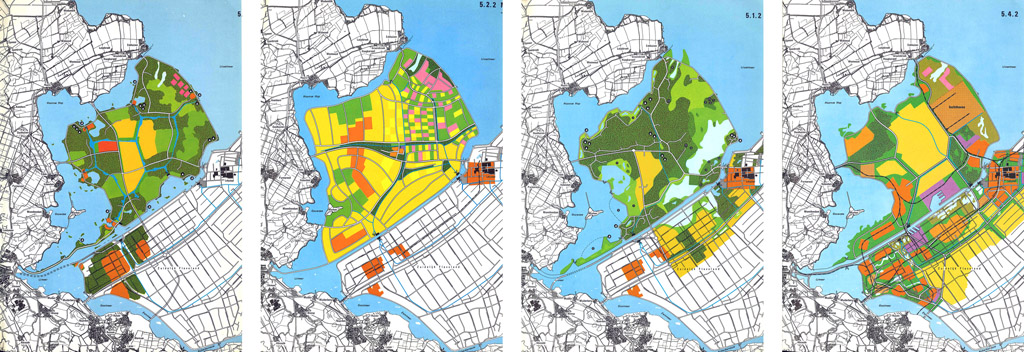ETH Zurich – Institute for Urban Design
HIL H44.1 – Stefano-Franscini-Platz 5 – 8093 Zurich
contact

The doctoral research project traced emergence, development, and impact of the scenario method in Dutch physical planning and design between 1970 and 2000.
Hypothetical, narrative, and vivid, scenarios ranged from elaborate interdisciplinary studies to provocative design sketches. Despite of their debatable effect, scenarios as comprehensive images of the future proliferated in an uncertain and increasingly communicative planning environment.
The research has three parts: (1) "Scenarios and the scenario method" explores the nature of scenario thinking and retraces the origin of scenarios in public planning from military strategic planning over futurology to French governmental physical planning. By discussing theoretical backgrounds and exemplary studies, fundamental definitions, techniques, and methods are introduced. The main part (2) "Scenarios in Dutch physical planning and design" is a history in the Netherlands from the 1960s to the 1990s. A brief introduction on history and 1960s theory of Dutch physical planning and design (2.1) is followed by the discussion of six cases: national physical planning studies by the RPD (2.2), urban planning of Almere (2.3), land reclamation plans for the Markerwaard (2.4), fundamental policy analyses by the WRR (2.5), the non-governmental urban design event NNAO (2.6), and design scenarios following the tradition of Situationism and Radical architecture (2.7). Each case explores a number of successive studies or projects, regards their historic context, their relation to the other cases, and an evaluation of the particular main function of scenarios. The projects were evaluated on their understanding, use, and application of the scenarios, the underlying actor networks, the working processes, the impact on practice and discussions, and the relation to the broader societal context and debates of their time. Part two closes with a brief account of the popularity of scenarios in the late 1990s and the ensuing disillusion regarding their usefulness (2.8). The final part (3) "Scenarios as tools" is an evaluation of the research through condensed answers to fundamental questions about the general function and potential value of scenarios in physical planning and design.
Scenarios always start from hypotheses about the future and develop a narrative. The combination of imagination and ratio, of synchronous and diachronous description, and the focus on the plausible is the core quality of scenarios. Aims, methods, and forms evolved and adapted significantly over time. Scenarios in physical planning and design originated in two separate fields: military strategic planning and governmental national planning on the one hand, and on the other, Situationism and Radical architecture. While scenarios based on both appoaches were of similar nature, they were different in aims and methods. Many scenario studies combined concepts from the socio-economic discipline of physical planning with design-led methods from urban design, architecture, and landscape architecture, notably in the large scale projects of land reclamation. In most cases, scenarios could not meet initial expectations to directly improve decision-making on spatial development. Indirectly, scenarios exerted great influence: non-governmental, governmental, and artistic physical planning and design scenario projects were central to Dutch disciplinary debates and the practices, notably during the late 1990s, when radical scenario projects received international attention. Through the central role of designers, these projects contributed to reestablish a design approach to spatial problems.
In physical planning and design, six major functions of scenarios could be distinguished: scenarios as planning device, scenarios as option generation device, scenarios as predictive device, scenarios as analytial device, scenarios as communicative device, and scenarios as romantic device. Studies based on the expectation of scenarios as planning or predictive device proved largely unsuccessful. This was mainly due to scenarios' inherent ambiguous nature as rationally structured speculations, which impeded both cognitive value and a productive external communication. As external communicative device, scenarios tended to be used for propaganda, especially in the form of trend-as-threat scenarios. For internal use, scenarios could be productive thought experiments for analysis and testing, option generation and morphogenesis, and opinion forming. The outcome depended on the underlying research question, the employed models, the data used, and the transparency of the process. Potential and limiation of scenarios are defined by their scale, their view of the future, and their scope. Not least, as and aid to the imagination, scenarios can serve as romantic device to stimulate unthought of ideas about the future.
The history of scenarios in physical planning and design in the Netherlands is exemplary for how the discipline developed and adapted its theory and its methods in a changing planning and societal context. The need for a communicative planning approach became apparent in recognition of increasing complexity and uncertainty, and an acceptance of a multiplicity of views, actors, and scales. In this situation, scenarios could proliferate because they provided comprehensive, large-scale, and long-range images of the future with an easily accessible narrative and vivid quality: Dutch New Worlds.
Dutch New Worlds: synoptic table of contents (pdf)
researcher: Christian Salewski
keywords: history of urban design; scenario method; the Netherlands; 1970-2000
2008-2010; supported by HGIS Culture Fund/The Netherlands Architecture Fund
This website has been archived and is no longer maintained.